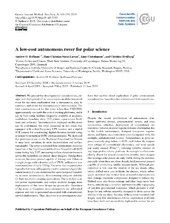| dc.contributor.author | Hoffman, Andrew | |
| dc.contributor.author | Christian Steen-Larsen, Hans | |
| dc.contributor.author | Christianson, Knut | |
| dc.contributor.author | Hvidberg, Christine | |
| dc.date.accessioned | 2020-04-13T13:42:10Z | |
| dc.date.available | 2020-04-13T13:42:10Z | |
| dc.date.issued | 2019-06-11 | |
| dc.Published | Hoffman A, Christian Steen-Larsen, Christianson K, Hvidberg C. A low-cost autonomous rover for polar science. Geoscientific Instrumentation, Methods and Data Systems. 2019;8(1):149-159 | eng |
| dc.identifier.issn | 2193-0864 | en_US |
| dc.identifier.issn | 2193-0856 | en_US |
| dc.identifier.uri | https://hdl.handle.net/1956/21842 | |
| dc.description.abstract | We present the developmental considerations, design, and deployment of an autonomous modular terrestrial rover for ice-sheet exploration that is inexpensive, easy to construct, and allows for instrumentation customization. The total construction cost for this rover is less than USD 3000, approximately one-tenth the cost of existing platforms, and it can be built using facilities frequently available at academic institutions (machine shop, 3-D printer, open-source hardware and software). Instrumentation deployed on this rover can be customized; the rover presented in this study was equipped with a dual-frequency GPS receiver and a digital SLR camera for constructing digital elevation models using structure-from-motion (SfM) photogrammetry. We deployed this prototype rover on the Northeast Greenland Ice Stream to map local variations in snow accumulation and surface topography. The rover conducted four autonomous missions based out of the East Greenland Ice-Core Project (EastGRIP) camp during July 2017, measuring surface elevation transects across the hazardous ice-stream shear margins. During these missions, the rover proved capable of driving over 20 km on a single charge with a drawbar pull of 250 N, sufficient to tow instrumentation of up to 100 kg. The rover also acquired photographs that were subsequently used to construct digital elevation models of a site monitored for spatiotemporal variability in snow accumulation, demonstrating adequate stability for high-resolution imaging applications. Due to its low cost, low-power requirements, and simple modular design, mass deployments of this rover design are practicable. Operation of the rover in hazardous areas circumvents the substantial expense and risk to personnel associated with conventional, crewed deployments. Thus, this rover is an investigatory platform that enables direct exploration of polar environments considered too hazardous for conventional field expeditions. | en_US |
| dc.language.iso | eng | eng |
| dc.publisher | Copernicus Publications | en_US |
| dc.rights | Attribution CC BY | eng |
| dc.rights.uri | http://creativecommons.org/licenses/by/4.0/ | eng |
| dc.title | A low-cost autonomous rover for polar science | en_US |
| dc.type | Peer reviewed | |
| dc.type | Journal article | |
| dc.date.updated | 2020-01-14T14:40:22Z | |
| dc.description.version | publishedVersion | en_US |
| dc.rights.holder | Copyright 2019 The Author(s) | en_US |
| dc.identifier.doi | https://doi.org/10.5194/gi-8-149-2019 | |
| dc.identifier.cristin | 1713328 | |
| dc.source.journal | Geoscientific Instrumentation, Methods and Data Systems | |

